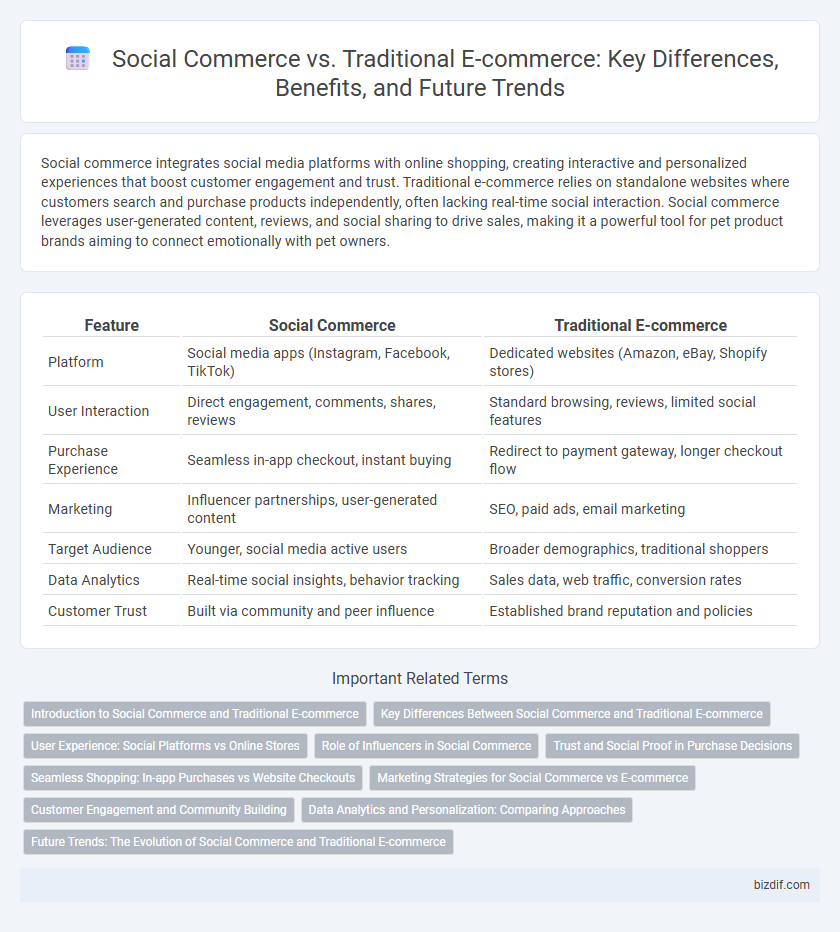Social commerce integrates social media platforms with online shopping, creating interactive and personalized experiences that boost customer engagement and trust. Traditional e-commerce relies on standalone websites where customers search and purchase products independently, often lacking real-time social interaction. Social commerce leverages user-generated content, reviews, and social sharing to drive sales, making it a powerful tool for pet product brands aiming to connect emotionally with pet owners.
Table of Comparison
| Feature | Social Commerce | Traditional E-commerce |
|---|---|---|
| Platform | Social media apps (Instagram, Facebook, TikTok) | Dedicated websites (Amazon, eBay, Shopify stores) |
| User Interaction | Direct engagement, comments, shares, reviews | Standard browsing, reviews, limited social features |
| Purchase Experience | Seamless in-app checkout, instant buying | Redirect to payment gateway, longer checkout flow |
| Marketing | Influencer partnerships, user-generated content | SEO, paid ads, email marketing |
| Target Audience | Younger, social media active users | Broader demographics, traditional shoppers |
| Data Analytics | Real-time social insights, behavior tracking | Sales data, web traffic, conversion rates |
| Customer Trust | Built via community and peer influence | Established brand reputation and policies |
Introduction to Social Commerce and Traditional E-commerce
Social commerce integrates social media platforms with online shopping, enabling users to discover, share, and purchase products directly within social networks like Instagram, Facebook, and TikTok. Traditional e-commerce relies on standalone websites or marketplaces such as Amazon and eBay, where consumers browse and buy products in a more transactional environment. Social commerce emphasizes user interaction, social proof, and community engagement, while traditional e-commerce focuses on product listings, search optimization, and streamlined checkout processes.
Key Differences Between Social Commerce and Traditional E-commerce
Social commerce integrates social media platforms directly into the shopping experience, enabling users to discover, share, and purchase products within apps like Instagram and Facebook, enhancing real-time interaction and user engagement. Traditional e-commerce, on the other hand, relies primarily on dedicated online stores and websites where transactions occur independently of social interactions, focusing on product catalogs and secure checkout processes. The key difference lies in social commerce's emphasis on community-driven purchase decisions and influencer marketing, whereas traditional e-commerce centers on streamlined navigation and comprehensive product information.
User Experience: Social Platforms vs Online Stores
Social commerce integrates shopping experiences directly within social media platforms like Instagram and Facebook, allowing users to discover and purchase products seamlessly while engaging with content and peers, enhancing interactivity and immediacy. Traditional e-commerce websites emphasize comprehensive product information, detailed reviews, and advanced filtering options, providing shoppers with a structured and focused browsing experience. User experience in social commerce leverages social proof and real-time engagement, whereas traditional e-commerce prioritizes extensive inventory management and transaction security.
Role of Influencers in Social Commerce
Influencers play a pivotal role in social commerce by leveraging their credibility and large follower base to drive authentic product recommendations, which significantly enhance consumer trust and engagement. Unlike traditional e-commerce that relies heavily on direct advertising and conventional marketing strategies, social commerce integrates influencer content seamlessly into shopping experiences on social platforms such as Instagram, TikTok, and Facebook. This integration boosts conversion rates by enabling real-time interaction, personalized endorsements, and community-driven buying decisions.
Trust and Social Proof in Purchase Decisions
Social commerce leverages user-generated content, reviews, and real-time interactions to build trust and provide social proof that directly influences purchase decisions. Traditional e-commerce relies heavily on product descriptions and ratings but lacks the dynamic engagement found in social media platforms. Consumers are more likely to convert when they see authentic peer recommendations and live demonstrations integrated into the shopping experience.
Seamless Shopping: In-app Purchases vs Website Checkouts
Social commerce enables seamless shopping experiences by integrating in-app purchases directly within social media platforms, eliminating the need to navigate away from the app. Traditional e-commerce relies on website checkouts that require users to visit external sites, often resulting in longer transaction times and higher drop-off rates. In-app purchases streamline conversion by offering instant payment options and personalized product discovery, significantly boosting customer engagement and sales.
Marketing Strategies for Social Commerce vs E-commerce
Social commerce leverages user-generated content, influencer partnerships, and social media platforms to create engaging, personalized shopping experiences that drive higher conversion rates compared to traditional e-commerce. Marketing strategies in social commerce emphasize community building and real-time interaction through features like live streaming and shoppable posts, enhancing brand trust and consumer engagement. Traditional e-commerce marketing relies heavily on search engine optimization (SEO), email campaigns, and pay-per-click (PPC) advertising to attract traffic and increase sales on standalone websites.
Customer Engagement and Community Building
Social commerce leverages interactive features like live streams, user reviews, and social sharing to boost customer engagement and foster a sense of community, driving higher conversion rates. Traditional e-commerce relies primarily on product listings and straightforward transactions, offering limited opportunities for real-time interaction or social connection. Brands integrating social commerce can create vibrant communities around their products, enhancing customer loyalty and repeat purchases.
Data Analytics and Personalization: Comparing Approaches
Social commerce leverages data analytics to harness consumer behavior insights from social interactions, enabling hyper-personalized shopping experiences through targeted recommendations and real-time engagement. Traditional e-commerce relies on transactional data and browsing history, using predictive algorithms to optimize product suggestions and inventory management. The integration of social signals in social commerce enhances data granularity, driving more precise personalization compared to conventional e-commerce platforms.
Future Trends: The Evolution of Social Commerce and Traditional E-commerce
Social commerce is rapidly evolving with integrated AI-driven personalized shopping experiences and seamless social media platform adaptations, enhancing customer engagement and driving impulsive purchases. Traditional e-commerce continues to advance through improved logistics, augmented reality product visualization, and robust data analytics for supply chain optimization. Future trends indicate a convergence where hybrid models leverage social interactivity combined with traditional ecommerce's scalability to create more immersive, efficient, and customer-centric online retail ecosystems.
Social Commerce vs Traditional E-commerce Infographic

 bizdif.com
bizdif.com